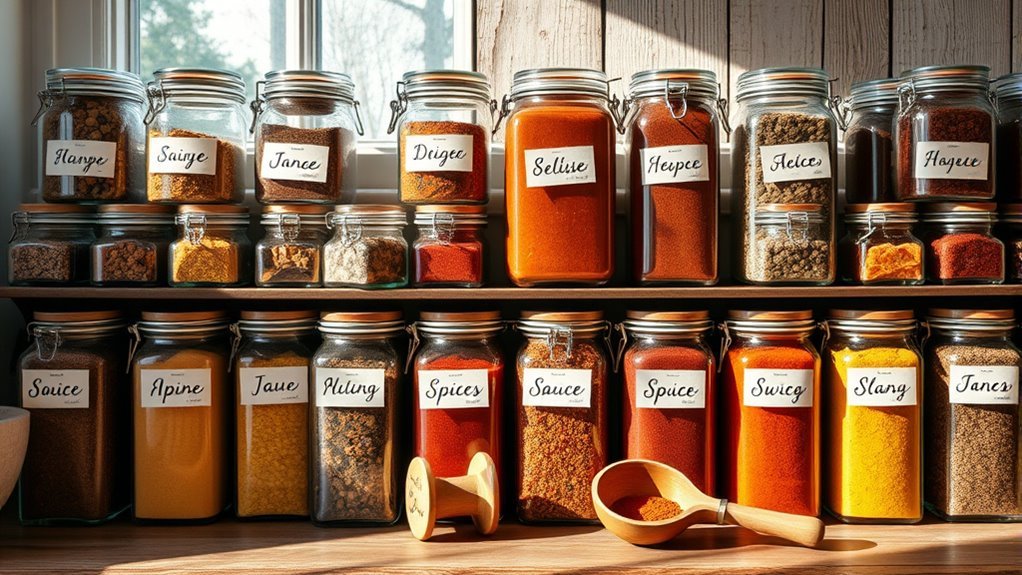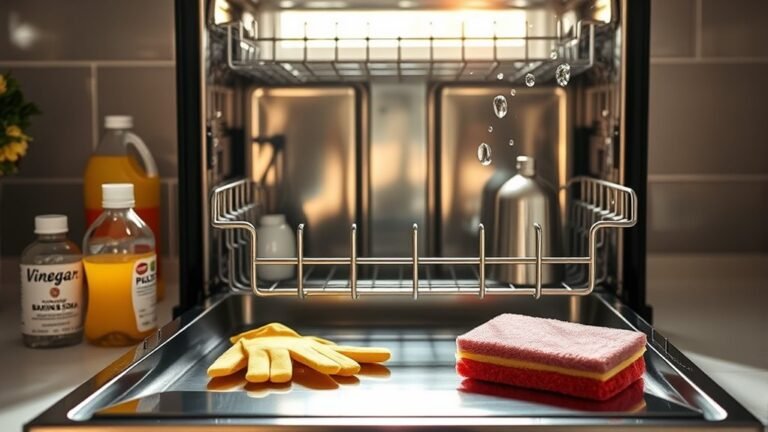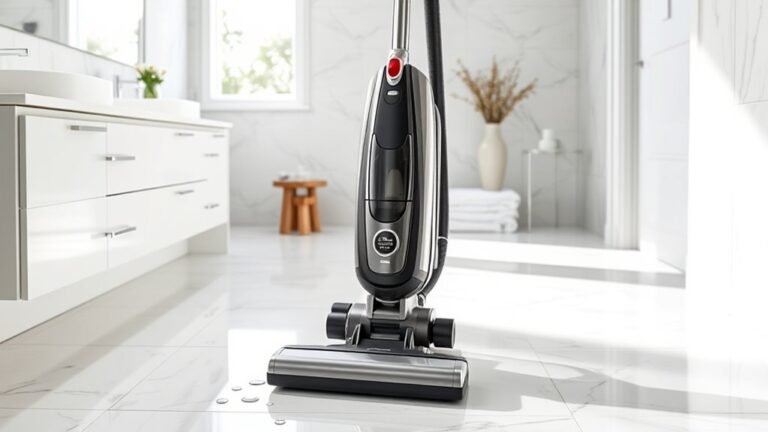How to Clean and Organize Your Spice Rack
Start by removing all spices to see what you have and clean your jars and shelves thoroughly to keep flavors fresh. Sort spices by type and how often you use them, placing your daily essentials within easy reach. Check expiration dates and toss any old or weak-smelling spices. Label your jars clearly for quick identification. Organize spices to balance convenience and style effortlessly. Keep going to discover tips that make your spice rack truly efficient and enjoyable.
Assess and Remove All Spices

The first step in cleaning and organizing your spice rack is to take everything off the shelves. This gives you a clear view of what you have and lets you start fresh. As you remove each jar, take a moment to create a spice inventory. Note which spices you use often and which ones have been sitting untouched. Using simple decluttering techniques, decide which spices you want to keep, toss, or donate. This process frees you from clutter and makes space for what truly matters in your kitchen. By evaluating and removing all spices, you’re creating the foundation for an organized, efficient spice rack that supports your cooking freedom and creativity. It’s about making your space work for you, not against you.
Clean Spice Jars and Shelves
Now that you’ve removed old spices, it’s time to clean the jars by wiping away any residue that might affect flavor. Make sure to scrub the shelves too, so everything stays fresh and tidy. Finally, arrange your jars thoughtfully to keep your spice rack easy to navigate.
Removing Old Residue
Before you start organizing, focus on removing old residue from your spice jars and shelves to guarantee everything’s clean and fresh. Take each spice jar and wipe the lid and neck where dust and spice particles tend to accumulate. Use a damp cloth or a gentle brush for residue removal, ensuring no stubborn bits remain that could affect your spices’ flavor. Don’t forget the shelves—wipe them down thoroughly to clear any powder or spills. This step frees you from lingering odors and sticky spots, creating a clean slate for your spices. When your spice jars and shelves are spotless, you’re ready to arrange your collection in a way that feels liberating and effortless. Removing old residue is the key to a fresh start.
Proper Shelf Arrangement
With your spice jars and shelves spotless, organizing them efficiently becomes much easier. Start by adjusting the shelf height to suit your spice jar sizes, ensuring you maximize vertical space without overcrowding. Think about accessibility options that fit your cooking style—whether you prefer pull-out racks, tiered shelves, or lazy Susans. This way, every spice is within easy reach, freeing you from frustration.
- Group spices by frequency of use, placing everyday ones at eye level.
- Use clear labels facing forward for quick identification.
- Arrange jars so the most accessible shelves hold your go-to spices, while less-used ones can occupy higher or lower spots.
Sort Spices by Type and Frequency of Use

Dividing your spices into categories based on type and how often you use them makes it easier to find what you need quickly. Start by grouping herb blends together—they often share similar spice origins and flavor profiles, so keeping them in one spot saves time. Next, separate spices by type: dried herbs, seeds, powders, and whole spices. Then, arrange these groups according to how frequently you cook with them. Place your daily essentials front and center, while less-used exotic spices can sit farther back or on higher shelves. This system gives you the freedom to grab what you want without hassle, freeing up mental space for creativity in the kitchen. Organizing this way also respects the unique origins and qualities of each spice, making your cooking experience smoother and more enjoyable.
Check Expiration Dates and Discard Old Spices
Now that you’ve sorted your spices by type and frequency, it’s a good idea to check their expiration dates. This freshness check guarantees your spice shelf stays vibrant and flavorful. Grab each jar and look for the date stamped on the label or lid. If you can’t find one, trust your senses: a dull aroma or faded color means it’s time to toss it.
Check spice jars for expiration dates or trust your senses—dull aroma or color signals it’s time to toss.
Here’s a quick way to keep your spice shelf fresh and free:
- Discard spices older than 2-3 years; ground ones lose potency faster.
- Check for clumping or discoloration—signs of moisture spoilage.
- Smell each spice; if it’s weak or off, say goodbye and make space for new ones.
This simple routine keeps your kitchen free and your flavors bold.
Label Jars Clearly and Consistently

Once you’ve cleared out old spices, labeling your jars clearly and consistently makes finding what you need quick and easy. Choose label types that suit your style and storage conditions—chalkboard labels offer flexibility, while waterproof vinyl labels provide durability. When selecting label materials, consider ones that resist smudging, especially in humid kitchens. Consistency is key: use the same font size, placement, and label shape across all jars to keep your spice rack visually organized and stress-free to navigate. You can even use a label maker or neatly handwritten tags if you prefer a personal touch. By investing a little time in consistent labeling, you’ll free yourself from fumbling through jars, making cooking more enjoyable and efficient.
Arrange Spices for Easy Access and Aesthetic Appeal
To make your spice rack both practical and visually pleasing, arrange spices based on how often you use them. Keep your everyday essentials within easy reach, and group less-used spices separately. Adding color-coded labels can help you quickly spot the right jar while enhancing the overall look.
Group by Usage Frequency
Grouping your spices by usage frequency can make cooking more efficient and your spice rack look neater. By organizing according to your usage habits, you’ll grab what you need faster and free up mental space for creativity. Start by identifying your most-used spices based on your cooking preferences. Then, arrange them where you can easily reach them.
Try this simple system:
- Place daily essentials like salt, pepper, and garlic powder front and center.
- Keep moderately used spices, such as cumin or paprika, just behind or to the side.
- Store rarely used or specialty spices in the back or on higher shelves.
This setup respects your freedom to cook spontaneously while keeping your spice rack tidy and functional.
Color Code Labels
Although organizing by usage frequency helps, adding color-coded labels can make your spice rack even easier to navigate and visually appealing. By tapping into color psychology, you can assign colors that evoke certain moods or signal spice types—reds for heat, greens for herbs, yellows for citrus notes. This intuitive system frees you from constant searching and adds a splash of personality to your kitchen. Choose durable label materials like waterproof vinyl or laminated paper to withstand spills and frequent handling. You can also customize labels with clear fonts and simple icons to boost quick recognition. With this approach, your spice rack won’t just be organized—it’ll invite you to explore flavors effortlessly and enjoy the freedom of an uncluttered, vibrant space every time you cook.
Frequently Asked Questions
How Often Should I Replenish My Spice Collection?
It’s wise to gently refresh your spice collection every six months to a year, as spices gradually lose their vigor over time. Paying attention to spice shelf life guarantees your dishes stay vibrant and flavorful. To savor that freedom of choice in cooking, store your spices in cool, dark places, away from heat and moisture. Following these spice storage tips helps you maintain a lively, inspiring culinary palette you’ll always enjoy.
Can Expired Spices Be Used for Anything Else?
You might wonder if expired spices still have a purpose. While they may lose potency in cooking, you can get creative with expired spices by using them for aromatic sachets to freshen up closets or drawers. They’re also great for composting spices, adding natural nutrients to your garden. Don’t feel limited—embrace these creative uses and give those old spices a new life beyond the kitchen!
What Are the Best Spices to Buy in Bulk?
Imagine your kitchen as a vibrant garden, where bulk purchasing spices like cinnamon, cumin, and oregano are the sturdy roots that keep flavors flourishing. You’ll want to focus on hardy spices with long shelf lives, so your spice storage stays fresh and ready for adventure. By buying in bulk, you free yourself from constant trips and enjoy the freedom to experiment boldly, knowing your pantry is stocked with versatile, reliable seasonings.
How Do I Prevent Spices From Losing Potency?
To keep your spices fresh and flavorful, focus on proper spice storage. Store them in airtight containers away from heat, light, and moisture—that’s key for potency preservation. Avoid clear jars near the stove; instead, choose dark glass or opaque containers in a cool, dry spot. Don’t buy more than you’ll use in a few months, so your spices stay vibrant and ready to release bold flavors whenever you want.
Are There Spices That Should Never Be Mixed Together?
“Variety is the spice of life,” but when it comes to spice pairings, you’ve got to be careful. Some spices clash because their flavor profiles just don’t harmonize—like mixing strong licorice notes with delicate floral ones. While you’re free to experiment, avoid combining overpowering spices that mask each other’s essence. Trust your palate, but remember, some blends are better left apart to keep each flavor shining bright.






